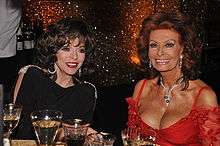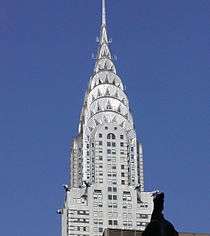Glamour (presentation)

- For other meanings, see Glamour (disambiguation). See also Fashion.
Glamour originally was a term applied to a magical-occult spell that was cast on somebody to make them see something the spell-caster wished them to see, when in fact it was not what it seemed to be. In the late 19th century terminology, a non-magical item used to help create a more attractive appearance gradually became known as 'a glamour'.[2] Today, glamour is the impression of attraction or fascination that a particularly luxurious or elegant appearance creates, an impression which is better than the reality. Typically, a person, event, location, technology, or product such as a piece of clothing can be glamorous or add glamour.
Virginia Postrel says that for glamour to be successful nearly always requires sprezzatura - an appearance of effortlessness, and to appear distant - transcending the everyday, to be slightly mysterious and somewhat idealised, but not to the extent it is no longer possible to identify with the person.[2] Glamorous things are neither opaque, hiding all, nor transparent showing everything, but translucent, favourably showing things.[3]
The early Hollywood star system in particular specialised in Hollywood glamour where they systematically glamorised their actors and actresses.[2]
Glamour can be confused with a style, which is adherence to a particular school of fashion, or intrinsic beauty; whereas glamour can be external and deliberate.
History
"Glamour" originally referred to be a magic spell, an illusion cast by Gypsies and witches.[3]
Late in the 19th century the common meaning shifted to being applied to ordinary objects and jewellery without connotations of supernatural, merely upon the effect that it has on appearance. This is a sense used in this article and to some extent is the way that it was used by the early Hollywood system.
In modern usage glamour is often confused with style or beauty; but they may be considered to be distinct, although glamour may give the appearance of beauty or present as a personal style.

Design
Many forms of architecture employ glamorous motifs to enhance the appearance of what may be otherwise mundane buildings. The Art Deco style is generally considered to be a glamorous one.[1]
Cinema
The "Golden Age" of "Hollywood Glamour" was the 1930s and 1940s, following the depression and its aftermath.[4]
Glamour is the result of chiaroscuro, the play of light on the landscape of the face, the use of the surroundings through the composition, through the shaft of the hair and creating mysterious shadows in the eyes. In Hollywood, stars as far apart as Marlene Dietrich, Carole Lombard, Rita Hayworth and Dolores del Rio, own and acquire glamor, technology and willingness to refine the beauty of its own... Are indecipherable magic of the cinema, substance of the dreams of a generation and the admiration of the following meeting", -filmmaker Josef von Sternberg, .[5]
Hollywood studios presented their female stars in designer gowns and exquisite jewelry,[6] both on screen and in carefully orchestrated occasions for publicity. Joan Crawford is quoted to have said, “I never go outside unless I look like Joan Crawford the movie star.”[7]
Photography was shot in rooms which had been specially painted to flatter the skin tone of the actors and actresses, and attention was paid to hair and clothes.[2] Notably this was successfully done with:
- Greta Garbo[4]
- Betty Grable[4]
- Grace Kelly[2]
- Hedy Lamarr[2] is quoted to have said "Any girl can be glamorous. All you have to do is stand still and look stupid."
- Sean Connery[2]
- Marilyn Monroe[2]
Icons
Glamour icons are people that are thought to epitomise glamour, that have an individual style that makes them more attractive.
For example:
- Brigitte Bardot
- Audrey Hepburn
- Imelda Marcos
- Queen Elizabeth II[8]
- Naomi Campbell[8]
- Diana, Princess of Wales
- Stella McCartney[8]
- Gloria, Princess von Thurn und Taxis
- Princess Isabelle, Countess of Paris
- Claudia Schiffer[8]
- Marella Agnelli
- Elizabeth Taylor
- Aishwarya Rai[8]
- Jacqueline Kennedy Onassis[8]
- Sophia Loren[9]
- Ava Gardner[9]
- Joan Collins[9]
- Caroline, Princess of Hanover, Hereditary Princess of Monaco (well-known worldwide simply as Princess Caroline of Monaco)
- Princess Grace of Monaco (also well known as Grace Kelly, her birth name and artistic name, as she wasn't a Princess in her own right, but rather consort of Rainier III, Prince of Monaco)
Photography

Glamour photography is the photographing of a model with the emphasis on the model and the model's sexuality and allure; with any clothing, fashion, products or environment contained in the image being of minor consideration. Photographers use a combination of cosmetics, lighting and airbrushing techniques to produce the most physically appealing image of the model possible.
Violence
Many types of media have been accused of glamorising violence, for example the film A Clockwork Orange by Stanley Kubrick or The Matrix.
The Grand Theft Auto video game series is listed in the Guinness Book of World Records 2009 as the most controversial game series and has often been accused of glamorising violence.[10]
See also
| Look up glamour in Wiktionary, the free dictionary. |
- Beauty - attractiveness
- Dandy
- Elegance - simple grace and dignified propriety
- Glam rock - a type of music where the musicians used outrageous glamours such as platform shoes and outrageous hairstyles
- Glamour photography Photography which shows a model, often nude or seminude
- Sprezzatura - to appear as without effort
- Style - dressing according to a school of thought
References
- 1 2 Fulford, Robert (13 September 2003). "Art Deco's glamour: Art Deco borrowed from the style of machines. The Deco artists loved surfaces that glittered, surfaces of glass, silver, steel, lacquer, then chromium and Bakelite". robertfulford.com. Retrieved 20 November 2010.
- 1 2 3 4 5 6 7 8 "TED conference Virginia Postrel".
- 1 2 "The Gilded Age". The New York Times. 2004-10-10. Retrieved 2010-05-03.
- 1 2 3 Zapata, Janet. "The democratization of glamour", Antiques
- ↑ Buena suerte viviendo:Dolores del Río
- ↑ "Hollywood Glamour: Fashion and Jewelry from the Silver Screen", Museum of Fine Arts, Boston
- ↑ Khvan, Olga. "MFA Shows Off Allure, Manipulation of ‘Hollywood Glamour’", Boston Magazine, September 9, 2014
- 1 2 3 4 5 6 Clout, Laura (2007-11-04). "Vogue names Queen as glamour icon". The Daily Telegraph. London. Retrieved 2010-05-03.
- 1 2 3 "Bookcost.net homepage".
- ↑ "GTA in The Guinness Book of World Records 2009". gra4.tv. Retrieved 20 November 2010.
Further reading
- Joseph Rosa, Phil Patton, Virginia Postrel, and Valerie Steele (2004). Glamour: Fashion, Industrial Design, Architecture. San Francisco Museum of Modern Art. ISBN 9780300106404.
- Stephen Gundle (2002). "Hollywood Glamour and Mass Consumption in Postwar Italy". In Rudy Koshar. Histories of Leisure. Berg Publishers. pp. 337–360. ISBN 9781859735251.
- Réka C. V. Buckley and Stephen Gundle (2000). "Fashion and Glamour". In Nicola White; Nicola Joanne White; Ian Griffiths. The Fashion Business. Berg Publishers. pp. 37–54. ISBN 9781859733592.
- Jeffrey Richards (1984). "Stars". The Age of the Dream Palace. Routledge & Kegan Paul PLC. pp. 157–158. ISBN 0-7100-9764-6.
